Mark Rothko
Mark Rothko, born in 1903 in Dvinsk, Russia, became one of the most influential figures in American abstract expressionism. His family immigrated to the United States when he was 10, and Rothko later attended Yale University before moving to New York City, where he fully embraced his artistic career. Early in his work, Rothko explored surrealism and mythological themes, but by the 1940s, he shifted towards his signature style—large-scale, abstract color fields.

Rothko’s paintings are known for their simplicity in form, yet emotional depth. Using vast blocks of color that often seem to float or glow, he sought to evoke deep emotional responses from viewers. His work wasn’t just about aesthetics but about expressing the human condition—he once said that his paintings could communicate basic human emotions such as tragedy, ecstasy, or doom. Rothko believed in the spiritual power of art and viewed his pieces as a form of mediation between the viewer and something greater.

I find myself gravitating toward his work because of its simplicity. There’s something emotionally raw that captures my attention, even if I can’t pinpoint what that is. I’m drawn to minimalist art in general—artists like Donald Judd and Agnes Martin, whose works also prioritize form and clarity. For me, there’s something powerful in how a piece can communicate so much with so little. Rothko’s canvases, with their fields of color, are aesthetically pleasing yet tap into something deeper, something that resonates beneath the surface, for me.
Rothko’s life ended tragically. Struggling with depression, he took his own life in 1970. However, his work continues to be celebrated for its ability to elicit introspection and emotional resonance, securing his legacy as a master of abstract art.
